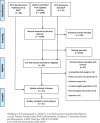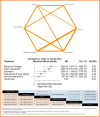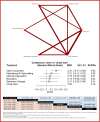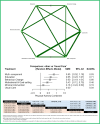Effectiveness of different intervention designs for improving physical activity in adults with cardiometabolic conditions over time: a systematic review and network meta-analysis of randomised controlled trials
- PMID: 40696422
- PMCID: PMC12285027
- DOI: 10.1186/s12916-025-04240-6
Effectiveness of different intervention designs for improving physical activity in adults with cardiometabolic conditions over time: a systematic review and network meta-analysis of randomised controlled trials
Abstract
Background: An active lifestyle can lessen the risk of cardiometabolic conditions and improve overall life quality. To support lifestyle change and help healthcare providers deliver optimal physical activity interventions, we aimed to compare the effectiveness of four different physical activity intervention designs (education, behaviour-change, motivational/goal-setting and multi-component) against usual care/minimal intervention in increasing physical activity among adults with cardiometabolic conditions.
Methods: A systematic review and network meta-analysis of randomised controlled trials (RCTs) were conducted. Four databases were searched (January 2000-February 2025).
Primary outcomes: steps per day, moderate-vigorous physical activity (MVPA) and combined physical activity.
Secondary outcomes: sedentary time, HbA1c, BMI, weight loss, SBP, DBP, cholesterol, LDL-C and HDL-C. Steps per day were analysed via time-course model-based meta-analysis. Bayesian random-effects network meta-analysis estimated mean differences (MD)/standardised mean differences (SMD) and 95% credible intervals (CrIs). Evidence quality was assessed using CINeMA.
Results: Sixty-two trials comprising 8952 participants were included, 51 were analysed in the meta-analysis. Behaviour-change (MD = 3287, 95% CrI 1576 to 4997 steps per day), multi-component (MD = 2939, 95% CrI 1714 to 4164), education (MD = 2054, 95% CrI 369 to 3740) and motivational/goal-setting (MD = 1344, 95% CrI 243 to 2445) interventions were significantly more effective than usual care in increasing steps per day. Overall, combined physical activity interventions excluding minimal interventions and when compared to usual care only, increased steps per day significantly from baseline by 143 (95% CrI 114 to 182; median 18 weeks), with the highest number of steps per day predicted at around 75 weeks from baseline (MD = 738, 95% CrI 581 to 893). Only multi-component interventions were consistently found to significantly increase physical activity across all primary measures-steps per day, MVPA and combined physical activity-compared to usual care or minimal care. In terms of secondary outcomes, motivational (MD = - 0.28%, CrI = - 0.46 to - 0.10%) and multi-component interventions were associated with significant HbA1c reductions (MD = - 0.24%, CrI = - 0.47 to - 0.02%) compared to usual care; no significant effects were found on other secondary outcomes.
Conclusions: Multi-component interventions were most effective at improving physical activity levels among people with cardiometabolic conditions. The crucial next step for patients, clinicians and policymakers is to enhance the understanding of how to tailor and implement these interventions effectively for sustained improvements in long-term physical activity levels.
Trial registration: PROSPERO number CRD42023405306.
Keywords: Cardiometabolic conditions; Intervention design; Network meta-analysis; Physical activity; Systematic review.
© 2025. The Author(s).
Conflict of interest statement
Declarations. Ethics approval and consent to participate: Not applicable. Consent for publication: Not applicable. Competing interests: The authors declare no competing interests.
Figures





Similar articles
-
Diet, physical activity and behavioural interventions for the treatment of overweight or obese children from the age of 6 to 11 years.Cochrane Database Syst Rev. 2017 Jun 22;6(6):CD012651. doi: 10.1002/14651858.CD012651. Cochrane Database Syst Rev. 2017. PMID: 28639319 Free PMC article.
-
Interventions for promoting habitual exercise in people living with and beyond cancer.Cochrane Database Syst Rev. 2018 Sep 19;9(9):CD010192. doi: 10.1002/14651858.CD010192.pub3. Cochrane Database Syst Rev. 2018. PMID: 30229557 Free PMC article.
-
Systemic pharmacological treatments for chronic plaque psoriasis: a network meta-analysis.Cochrane Database Syst Rev. 2021 Apr 19;4(4):CD011535. doi: 10.1002/14651858.CD011535.pub4. Cochrane Database Syst Rev. 2021. Update in: Cochrane Database Syst Rev. 2022 May 23;5:CD011535. doi: 10.1002/14651858.CD011535.pub5. PMID: 33871055 Free PMC article. Updated.
-
Falls prevention interventions for community-dwelling older adults: systematic review and meta-analysis of benefits, harms, and patient values and preferences.Syst Rev. 2024 Nov 26;13(1):289. doi: 10.1186/s13643-024-02681-3. Syst Rev. 2024. PMID: 39593159 Free PMC article.
-
Mobile phone-based interventions for improving adherence to medication prescribed for the primary prevention of cardiovascular disease in adults.Cochrane Database Syst Rev. 2018 Jun 22;6(6):CD012675. doi: 10.1002/14651858.CD012675.pub2. Cochrane Database Syst Rev. 2018. Update in: Cochrane Database Syst Rev. 2021 Mar 26;3:CD012675. doi: 10.1002/14651858.CD012675.pub3. PMID: 29932455 Free PMC article. Updated.
References
-
- American College for Cardiology. Cardiometabolic initiatives. Available: https://www.acc.org/tools-and-practice-support/quality-programs/cardiome.... Last Accessed 2 Apr 2023.
-
- NICE. Type 2 diabetes in adults: management. National Institute for Health and Care Excellence. 2022. https://www.nice.org.uk/guidance/ng28. - PubMed
-
- British Heart Foundation. UK factsheet. 2023. Available at: https://www.bhf.org.uk/-/media/files/for-professionals/research/heart-st....
-
- UK Parliament. House of commons library. Obesity statistics. Published Thursday, 12 January, 2023. Available at: https://researchbriefings.files.parliament.uk/documents/SN03336/SN03336.pdf.
Publication types
MeSH terms
LinkOut - more resources
Full Text Sources
Medical

